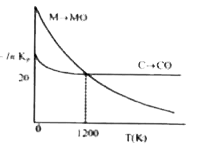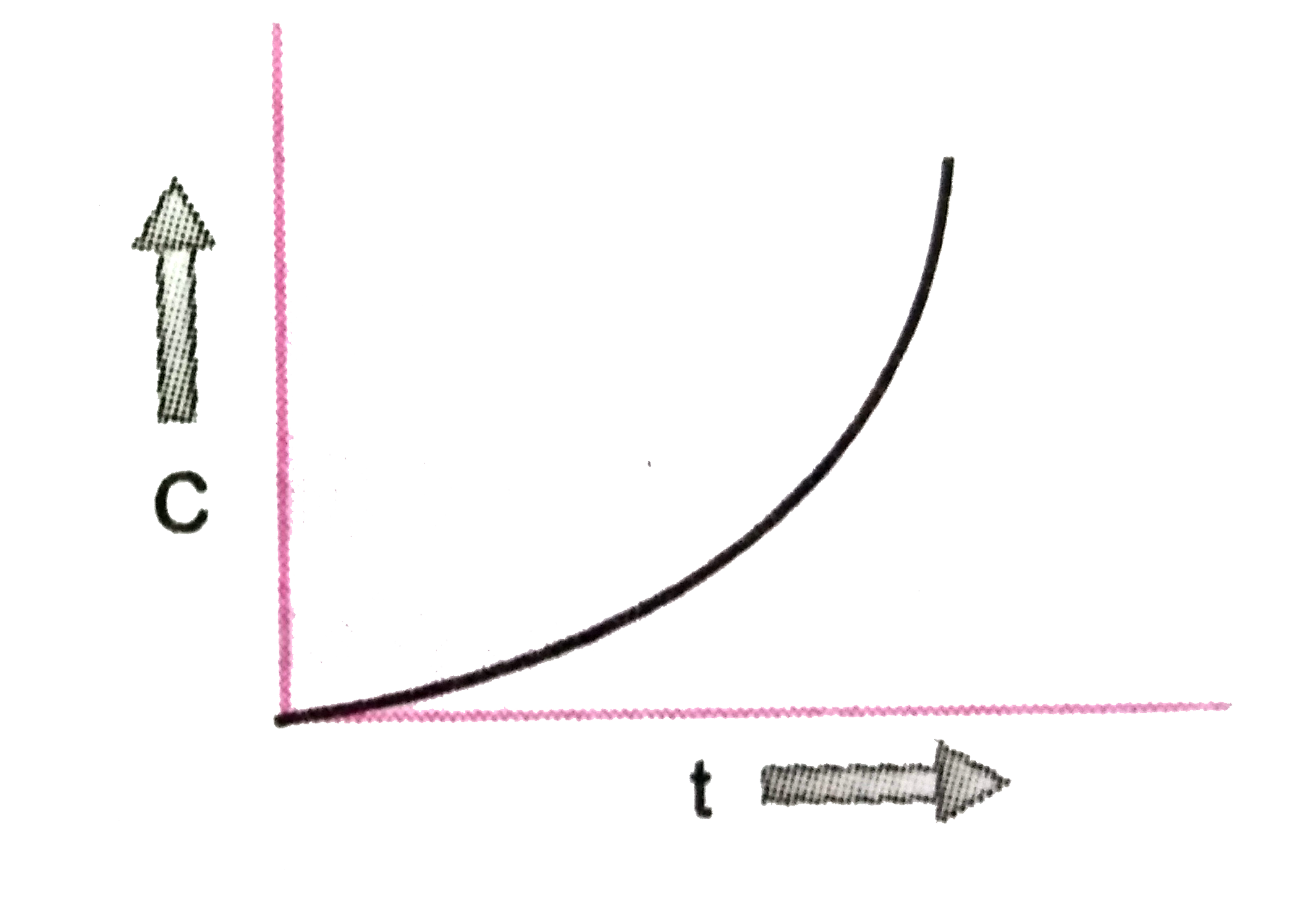Explore topic-wise InterviewSolutions in .
This section includes InterviewSolutions, each offering curated multiple-choice questions to sharpen your knowledge and support exam preparation. Choose a topic below to get started.
| 25751. |
The plots of (1)/(x_(A)) (on y-axis) (1)/(y_(A)) (on x-axis) is linear with slope and intercept respectively. p^(@)A = vapour pressure of pure liquid A p^(@)B = vapour pressure of pure liquid B |
|
Answer» <P>`(p_(A)^(@))/(p_(B)^(@))` and `((p_(A)^(@)-p_(B)^(@)))/(p_(B)^(@))` |
|
| 25752. |
The plot shows the variation of -InK_(p) versus temperature for the two reactions. M(s)+(1)/(2)O_(2)(g)toMO(s)andC(s)+(1)/(2)O_(2)(g)toCO(s) Identify the correct statement : |
|
Answer» At `Tlt1200K`, oxidation of CARBON is unfavourable.  At `Tlt1200K`, carbon will reduce MO(s) to M(s) HENCE, chemical reaction `MO(s)+C(s)toM(s)+CO(g)` is spontaneous. |
|
| 25753. |
The plot of x/m versus temperature at constant pressure is called |
|
Answer» ADSORPTION ISOTHERM |
|
| 25754. |
The plot of partial vapour vapour pressure of solvent verses its mole fraction in the solution of a constant temp.is |
|
Answer» <P>a STRAIGHT LINE |
|
| 25755. |
The plot of t(1)/(2) V/s [R]0 for a reaction is a straight-line parallel to x-axis.The unit for the rate constant of this reaction is |
|
Answer» MOL `L^(-1)` s `:.` Unit of RATE CONSTANT `= s^(-1)` |
|
| 25756. |
The plot of 1/X_(A) vs 1/Y_(A) (where X_(A) and Y_(B)) are the mole fractions oif A in liquid and vapour phases respectively) is linear whose slope and intercept respectively are given as |
|
Answer» <P>`P_(A)^(@)/P_(B)^(@).(P_(A)^(@) - P_(B)^(@))/(P_(B)^(@))` |
|
| 25757. |
The plot of (1)/(Y_(A))" Vs "(1)/(x_(A))((1)/(Y_(A))" on y - axis") where A and B form a ideal solution. Y is mole fraction in vapour phase and X is mole fraction in liquid phase, is linear with slope and inercept respectively |
|
Answer» <P>`(P_(A)^(0))/(P_(B)^(0)) and (P_(A)^(0)-P_(B)^(0))/(P_(B)^(0))` |
|
| 25758. |
The plot of log k vs 1/T helps to calculate |
|
Answer» ENERGY of activation |
|
| 25759. |
The plot of In k versus 1/T is liner with slope of |
|
Answer» `E_a/R` |
|
| 25760. |
The plotof 1//x_(A) versus 1//y_(A) (where X_(A) and Y_(A) are the mole fraction of A in liquid and vapour phases, respectively ) is linear with slope and intercept respectively are given as (y-axis=1//y_(A), x-axis =1//x_(A)) |
|
Answer» <P>`P_(A)^(0)//P_(B)^(0), (P_(A)^(A)-P_(B)^(0))//P_(B)^(0)` |
|
| 25761. |
The plot between concentration versus time for a zero order reaction is represented by |
|
Answer»
or `[A] = - kt + [A]_(0)`. Thus, Plot of [A] vs t is LINEAR with `-ve` SLOPE `( = -k)` |
|
| 25762. |
The plots of (1)/(X_(A))vs.(1)/(Y_(A)) (where X_(A) and Y_(A) are the mole fraction of liquid A in liquid and vapour phase respectively) is linear with slope and intercept respctively are given as: |
|
Answer» `P_(A)^(@)/P_(B)^(@),((P_(A)^(@)-P_(B)^(@)))/(P_(B)^(@))` `P_(A)=X_(A)P_(A)^(@),P_(B)=X_(B)P_(S)^(@)` `Y_(A)P_(A)/(P_(A)+P_(B))=(x_(B)P_(S)^(@))/(X_(A)P_(A)^(@)+X_(B)P_(B)^(@))` `or 1/Y_(A)=(P_(A)^(@)-P_(B)^(@))/P_(A)^(@)+P_(B)^(@)/P_(A)^(@)xx1/X_(A)` `or P_(B)^(@)/(X_(A)P_(A)^(@))=1/Y_(A)-[(P_(A)^(@)-P_(B)^(@)]/P_(A)]` `1/X_(A)=P_(A)^(@)/P_(B)^(@)[1/Y_(A)+((P_(B)^(@)-P_(B)^(@)))/P_(A)^(@)]` `=P_(A)^(@)/P_(B)^(@)xx1/Y_(A)+((P_(B)^(@)-P_(A)^(@)))/P_(B)^(@)` Hence PLOT of `1/X_(A)vs1/Y_(A)` will be liner with slope =`P_(A)^(@)/P_(B)^(@)"and intercept"=((P_(B)^(@)-P_(A)^(@)))/P_(B)^(@)` |
|
| 25763. |
The platinum catalyst used in the oxidation of SO_2by contact process is poisoned by_______. |
|
Answer» `As_2O_3` |
|
| 25764. |
The platinised plate in SHE is used as __________. |
|
Answer» OXIDISING agent |
|
| 25765. |
The plastics if are hard, become soft and readily workable by addition of certain compound called |
|
Answer» Catalyst |
|
| 25766. |
What is plaster of paris ? |
|
Answer» `CaSO_4.2H_2O` |
|
| 25767. |
The plant cell will shrink when placed in: |
|
Answer» WATER |
|
| 25768. |
The plant cells will shrink when placed in |
|
Answer» Water |
|
| 25769. |
The planar complex [M_(ABCD)] gives: |
|
Answer» TWO OPTICAL isomers |
|
| 25770. |
The pK_(SP) of Agl is 16.07. If the E^(@) value for Ag^(+)//Ag is0.7991 V, find the E^(@) for hlaf cell reaction : AgI_((s)) + e rarr Ag + I^(-) |
|
Answer» |
|
| 25771. |
The pK_c of equimolecular sodium acetate and acetic acid mixtuare is 4.74. If pH is : |
|
Answer» 1.4 |
|
| 25772. |
The pkb values of Ammonia, methanamine and Benzenamic (aniline) are 4.75, 3.38 and 9.38 respectively. Arrange them in the increasing order of their basic strength. |
| Answer» SOLUTION :`UNDERSET(3.38)("Methanomine")GT underset(4.75)("AMMONIA")gt underset(9.38)("bensenomine")` | |
| 25773. |
The pK_b value of ammonium hydroxide is 4.75. An aqueous solution of ammonium hydroxide is titrated with HCl. The pH of the ammonium hydroxide has been neutralized will be |
|
Answer» 9.25 |
|
| 25774. |
The pK_(a_1), pK_(a_2) and pK_(a_3) value for the amino acid cysteine (HS-CH_2-undersetunderset(NH_2)(|)CH-COOH) are respectively 1.8, 8.3, 10.8. What is isoelectric point of cysteine amino acid ? |
|
Answer» <P> SOLUTION :`p^(|)=(pK_(a_2))+pk_(a_3))/2=(8.3+10.8)/2=8.85` |
|
| 25775. |
The pK_(b) value is highest for : |
|
Answer» <P>p - METHOXY aniline |
|
| 25776. |
The pK_(a0 of a weak acid (HA) is 4.5. The pOH of an aqueous buffered solution of HA in which 50% of the acid is ionized is : |
|
Answer» `2.5` `pH=pK_(a)+"log"(["conjugate base"])/(["Acid"])` `=4.5+"log"(0.5c)/(0.5c)=4.5` `therefore POH = 14-4.5=9.5` |
|
| 25777. |
The pka values for the three ionizable groups x, y & z of glutamic acid are 4.3, 9.7 & 2.2 respectively underset((x))(HOOC)-CH_(2)-underset((y))underset(+NH_3)underset(|)(CH)-underset((z))(COOH) The isoelectric point for the amino acid is : |
|
Answer» |
|
| 25778. |
The Pk_(a) value of the C-H acids HC -= CH (I), MeCOCH_(2)COOEt (II), MeCOOEt (III) and PhMe (IV) decreases as |
|
Answer» `I gt III gt IV gt II` `CH_(3)-overset(O)overset(||)C_OEt overset("base")to overset(-)CH_(2)-overset(O)overset(||)C-OEt harr CH_(2)=overset(O^(-))overset(|)C-OEt harr "etc."`  Among `HC -= CH` and `MeCOCH_(2)COOEt` is a stronger acid than `HC -= CH` since the carbanion from `MeCOCH_(2)COOEt` is resonance stabilized by two carbonyl groups. `CH_(3)-overset(O)overset(||)C-CH_(2)-overset(O)overset(||)C-OEt overset("base")to CH_(3)-overset(O)overset(||)C-CH-overset(O)overset(||)C-OEt harr CH_(3)-overset(O^(-))overset(|)C=CH-overset(O)overset(||)C_OEt harr CH_(3)-overset(O)overset(||)C_CH=overset(O)overset(|)C-OEt` while the carbanion, i.e., `CH -= C^(-)` from `CH -= CH` is stabilized only by the greater electronegativity of the sp-carbon. Thus the overall acidity decreases in the order, `MeCOCH_(2)COOEt gt HC -= CH gt MeCOOEt gt PhMe`. Since a stronger acid has a lower `pK_(a)` value, `pK_(a)` VALUES decrease in the opposite order, i.e., `PhMe gt MeCOOEt gt HC -= CH gt MeCOCH_(2) COOEt`. In other words, `pK_(a)` values decrease in the order : `IV gt III gt I gt II` |
|
| 25779. |
The pKa values for the three acidic group P,Q,R are 4.3, 9.7 and 2.2 respectively, Calculate the isoelectric point of the amino acid? |
|
Answer» `7.00` |
|
| 25780. |
The pKa ofHCN is 9.30. The pH of a solution prepared by mixing 2.5 moles of KCN and 2.5 moles of HCN in water and making up the total volume of 500 ml is : |
|
Answer» `9.30` `pH=9.30+"log"((2.50))/((2.50))` `= 9.30`. |
|
| 25781. |
The pK_a of HCN is 9.30. The pH of a solution prepared by mixing 2.5 moles of KCN and 2.5 moles of HCN in water and making up the total volume of 500 mL is : |
|
Answer» `9.30` |
|
| 25782. |
The pK_a of an indicator is 4. Its working range lies in beetween pH: |
|
Answer» 1-5 |
|
| 25784. |
The pk_a of acetylsalicylic acid (aspirin) is 3.5. The PH of gastric juice in human stomach is about 2-3 and the pH in the small intestine is about 9. Aspirin wil be |
|
Answer» UNIONIZED in the SMALL intestine and in the stomach |
|
| 25785. |
The pK_(a) of acetylsalicylic acid (aspirin) is 3.5. The pH of gastric juice in human stomach is about 2-3 and the pH in the small intestine is about 8. Aspirine will be |
|
Answer» Unionised in the small intestineand the STOMACH |
|
| 25786. |
ThepK_(a)of acetylsaliclyicacid (aspirin) is 3.5.The pH ofgastric juicein human stomachisabout2 - 3and pH in thesmall intestine is about 8. Aspirin will be . |
|
Answer» UNIONIZED in the SMALLINTESTINE and in the STOMACH |
|
| 25787. |
The pK_(a) of a weak acid is 4.8. What should be the ratio of [Acid]/[Salt] of a buffer if pH = 5.8 is required |
|
Answer» 10 `5.8 = 4.8 + log.(["Salt"])/(["Acid"])` or `log.(["Salt"])/(["Acid"]) = 1.0` `(["Salt"])/(["Acid"]) = "antilog 1.0" = 10` `:. (["Salt"])/(["Acid"]) = (1)/(10) = 0.1`. |
|
| 25788. |
The pK_(a) of a weak acid is 4.8. What should be the ratio of [Acid]/[Salt] of a buffer if pH = 5.8is required ? |
|
Answer» `0.1` |
|
| 25789. |
The pk_(a) of a weak acid, HA is 4.8. The pK_(b) of a weak base, BOH is 4.78. The pH of an aqueous solution of the corresponding salt, BA will be |
|
Answer» 4.79 `PH = 7+(1)/(2)(pK_(a) - pK_(b)) = 7 + (1)/(2)(4.8 - 4.78) = 7.01`. |
|
| 25790. |
The pK_(a) of a weak acid (HA) is 4.5 the pOH of an aqueous buffered solution of HA in which 50% of the acid is ionized is |
|
Answer» 4.5 `PH = pK_(a) + log.(["SALT"])/(["Acid"]) = 4.5 + log.(["Salt"])/(["Acid"])` as HA is 50% ionized so [Salt] = [Acid] pH = 4.5 pH + pOH = 14 `rArr pOH = 14 - 4.5 = 9.5`. |
|
| 25791. |
The pK_(a) for acetyl salicylic acid (aspirin) is 3.5. The pH of gastric juice in the human stomach is about 2-3 and the pH in the small intestine is about 8. Aspirin will be |
|
Answer» un-ionised in the SMALL INTESTINE and in the STOMACH |
|
| 25792. |
The pink colour of phenolphthalein in alkaline medium is due to : |
| Answer» Answer :A | |
| 25793. |
The pink colour of phenolphthalein in alkaline medium is |
|
Answer» DUE to negative form |
|
| 25794. |
The pi electron cloud of C_(1)-C_(2) is present in the plane of paper than which of the following is incorrect? |
|
Answer» `Z` is perpendicular to the PLANE of PAPER |
|
| 25795. |
The pigment responsible for photosynthesis is a coordination compound of magnesium. |
|
Answer» |
|
| 25796. |
The pi-acid ligand which uses its d-orbital during synergic bonding in its complex compound: |
|
Answer» `NO^(+)` |
|
| 25797. |
The pi acid ligand which uses it d-orbital during synergic bonding in its complex compound. |
|
Answer» `CN^(-)` |
|
| 25798. |
The pi bonds in SO_2 molecule arises due to _________ overlap. |
|
Answer» <P>`SIGMA` |
|
| 25799. |
The pi- bond in carbonyl group is formed by |
|
Answer» s-s-overlapping |
|
| 25800. |
The physical properties of a material show different values when measured in different directions. What is this property known as ? |
| Answer» SOLUTION :ANISOTROPY | |



